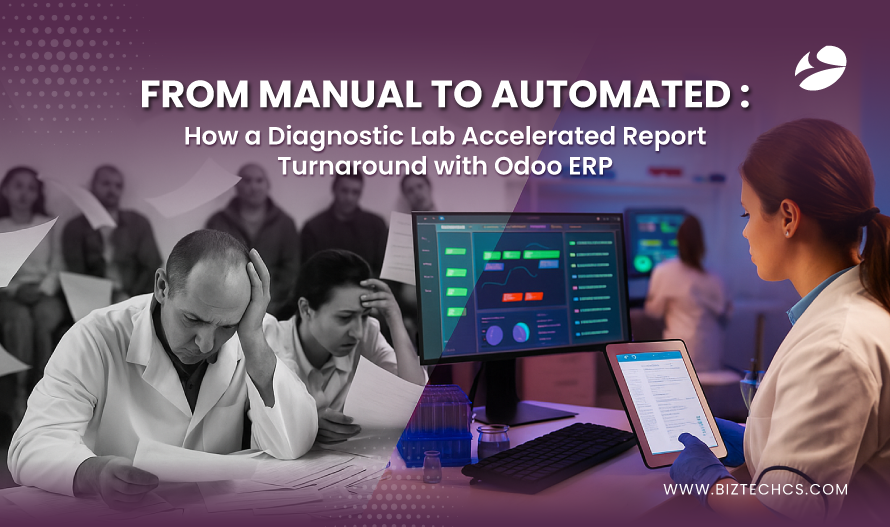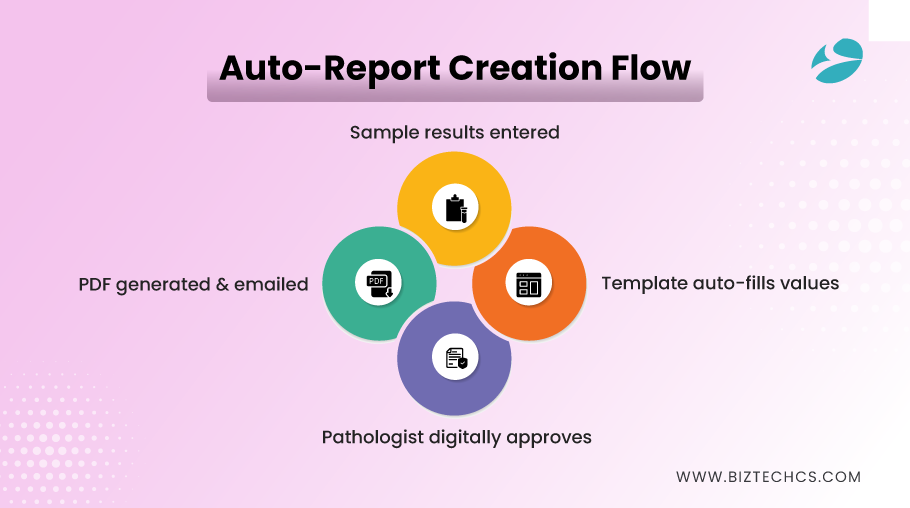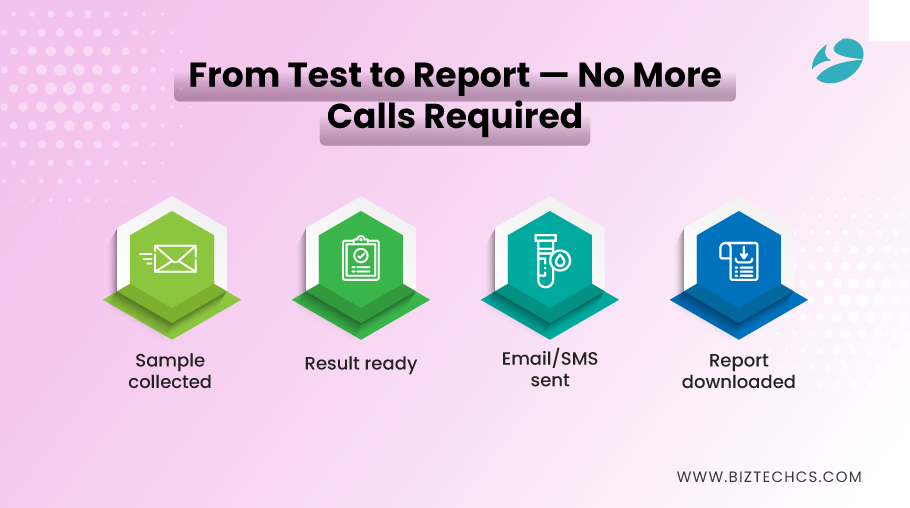116
From Manual to Automated: How a Diagnostic Lab Accelerated Report Turnaround with Odoo ERP
5 min read
116
5 min read
Table of Content

In a busy diagnostic laboratory at the health district in Dubai, the day begins with a steady flow of patients at the reception, each carrying a prescription slip. Inside, lab technicians increasingly handle test samples as they juggle between outdated software, Excel spreadsheets, and manual data entry.
Dr. Sarah, the lab director, regularly observes the challenges her team faces. Samples often arrive in handwritten containers—some with unclear labels—while staff move between departments, entering data into different systems that don’t communicate with each other. The pathology unit, chemistry department, and billing all run on separate platforms, adding to the complexity.
Fragmented systems sometimes cause delays and omission of steps. Moreover, clinical workflows and patient trust are disrupted when critical test results are delayed due to manual processes. To address such issues, the lab management began exploring more integrative and automated solutions. Their search led them to BiztechCS, an Odoo Partner with a strong track record in healthcare ERP implementations across the Middle East.
Expert Insight:
“Many diagnostic labs don’t realize how interconnected their processes are,” explains a BiztechCS consultant. “From sample tracking to reporting and billing, each step impacts the next. We begin by mapping these dependencies before recommending any Odoo modules—it helps avoid costly implementation errors.”
The accumulated burden of manual labor in clinical labs becomes apparent when one looks across departments. For example, the initial two hours in a day for Lab Technician Ahmed are used in reconciling sample numbers between the registration system and the testing queue.
Since the laboratory information management system (LIMS) is not integrated with the billing platform, he manually cross-checks test requests with insurance approvals, often detecting discrepancies that necessitate time-consuming phone inquiries to resolve.
Upstairs, Dr. Aisha, the lab director, spends at least 3 hours every day going through test reports. She manually flags abnormal results, verifies the reference ranges for different analyzer calibrations, and oversees the communication of critical values to physicians herself. In the absence of automated alerts, urgent digital results remain in limbo while clinicians are unaware of updates critical for patients.
Less tangible time-wasting is detrimental to the whole healthcare delivery chain. Turnaround time can lead to insurance claims being denied, patients complaining, and clinician irritation increasing. Delays in emergency departments can sometimes result in samples being routed to external labs, which can adversely affect revenue and market share.
Even more disturbing, many labs struggle to estimate the cost of these broken systems accurately. An implementation team consulting a lab in Abu Dhabi showed that manual transcription errors from systems caused 23% of all the testing delays. Only after a detailed audit did the lab actually realize the extent of the problem-the baseline is known to be essential to ensure automation is implemented properly. Without that, transparent quantification of the amount saved in time and reduced errors, and reliability is not even possible upon implementation of any solution, such as Odoo ERP Development.
As smarter workflows are being introduced for healthcare organizations worldwide, the lab automation market is growing due to the need for precision, efficiency, and seamless system integration. In this scenario, Odoo implementation in phases is a strategic choice. Staged implementation of automation—primarily billing, LIMS, and notification modules—retains continuity and gradually enhances interoperability.
Ultimately, disconnected workflows not only incur operational costs but also damage reputation. Every second counts in this sector, so revising the fragmented workflow is a must-have rather than a convenience.
The crunch time began when BiztechCS took its first steps in diagnosing and assessing workflows, one of the rare instances where every patient touchpoint was mapped, from registration to final report delivery. Unlike generic ERP implementations, this analysis was conducted with the specific requirements of a diagnostic lab in mind: sample tracking protocols, equipment integration capabilities, regulatory compliance automation, and real-time quality monitoring.
Odoo was chosen as the best fit, being modular, allowing the lab to first implement the basic core functionalities before gradually moving into more specialized features. On the BiztechCS side, the inventory management was configured to track reagent expiration dates, set automatic reorder points for consumables, and manage equipment maintenance.
The CRM module was tailored to manage physician relationships, communications with insurance providers, and patient notification preferences.
Sample management, for the purposes of this implementation, became a crucial system, enabling specimens to be tracked using barcode scanning techniques throughout the collection, sample processing, result, and report stages. Each sample received a unique identifier linked to patient demographics, test parameters, billing information, and quality control metrics through Odoo’s integrated platform.
Initially, real-time dashboards provided instant monitoring across departments, enabling labs to track pending tests, equipment status, reagent level inventory, and staff performance through a single-window interface in Odoo. Quality assurance teams received automated alarms for calibration expiry, control failure, and results with abnormal patterns, requiring further investigation.
As such, change began to materialize due to the various capabilities of Odoo that can fulfill operational challenges within a diagnostic lab ecosystem.
One of the earliest significant changes was the introduction of sample management by barcode. Before its inception, they were still battling human errors induced by handwritten sample labels, as well as manual tracking systems. At the time of specimen registration, the system generated barcodes that uniquely tied the sample to patient information, requested tests, physician information, and billing codes within a single record. This created traceability, but it also minimized errors and saved time that was being sacrificed on data entry.
The feature introduced automatic report generation, revolutionizing the laboratory workflow. Upon entering the results into the system, Odoo would select its predefined templates for uniform formatting across all four test types.
Abnormally high or low values would be flagged by the built-in quality control check for that pathologist. It would calculate reference ranges on its own, depending on age, gender, and other demographic considerations; provide color-coded information intuitively for critical values; and electronically sign for approved personnel to create a smooth workflow from analysis to dispatch.
The integration of instruments created a significant leap in functionality. Custom APIs developed by BiztechCS linked Odoo directly to automated analyzers, hematology counters, blood gas analyzers, and chemistry platforms. This mechanism enabled instruments to transmit real-time data directly into patient records, eliminating transcription errors and reducing processing times by 70%.
To satisfy the varying needs of different lab roles, Odoo provided role-specific dashboards. Laboratory technicians were granted explicit insights into their designated worklists, sample status, and quality control activities. Managers accessed high-level KPIs, such as turnaround times and equipment utilization, while billing teams tracked insurance approvals, payments, and collections—all from within the same platform.
Another important feature that helped ensure quality control and regulatory compliance was Odoo’s complete audit trail. Each activity that took place, from entering data and modifying results to accessing the system, was registered automatically, with a timestamp, user ID, and justification note. It thus fully complied with the regulations of the DHA and international standards of quality.
Of course, the psychological impact of this real-time visibility cannot be underestimated. Once the laboratory staff understand exactly where a sample is in the process, anxiety is reduced, and productivity begins to rise.
The transparent workflow tracking implementation in Odoo has led to an improvement in staff satisfaction scores of up to 15%, which is a testament to how clarity in operations boosts morale and productivity.
As they expand across geographies, a common question arises: How does Odoo facilitate communication in multi-location operations, when labs need to share results between different branches or satellite collection centers?
The platform’s architecture supports centralized data management with location-based permissions, allowing seamless result sharing, sample tracking, and workload balancing across distributed sites, ensuring consistency, compliance, and collaboration on a whole new level.

The customization process extended beyond basic Odoo functionality to address the unique operational complexities of diagnostic laboratories. BiztechCS developed specialized modules for lab queue optimization that automatically prioritized urgent samples, balanced workloads across available staff, and predicted processing bottlenecks during peak hours using Odoo’s project management capabilities.
Reagent consumption tracking was automated through integration with Odoo’s inventory management system. The system monitored reagent usage patterns for each test type and predicted consumption rates based on past usage.
Orders were generated whenever inventories approached the defined minimum limits. An expiration date tracking system ensured that reagents were used on a first-in, first-out basis, minimizing the use of expired material.
The doctor-lab communication channels facilitated professional interactions via secure messaging, automatic result notifications, and customizable report formats within the Odoo communication framework. Doctors could specify how they wanted results delivered for various test types: email for routine results, SMS alerts for critical values, and calls for emergency findings.
Odoo Studio provided flexibility to modify workflows without extensive programming knowledge. Lab managers could adjust report templates, modify quality control procedures, and customize user interfaces based on evolving requirements. This capability proved essential during regulatory updates and operational improvements.
The transformation was a strategic business intelligence concept that completely altered how the laboratory approached capacity planning and resource management. With Odoo’s analytical capabilities, the lab can identify patterns in test volume fluctuations and, accordingly, outsource staff during seasonal health trends, such as the flu season or peaks in chronic disease cases during Ramadan.
Through analyzing data from the past in conjunction with outlying variables such as health campaigns, referral patterns from doctors, and changes in insurance coverage, intelligent forecasting became possible. These predicted spikes in test loads with 85% accuracy, effectively allowing management to take proactive steps in adjusting schedules, ordering supplies, and hiring temporary staff well in advance of any capacity requests.
Predictive maintenance scheduling monitored and maintained the equipment via the Odoo maintenance module by tracking usage patterns, performance indicators, and manufacturer recommendations. These would be scheduled for calibration, preventive maintenance, and quality control procedures based on the actual usage of the equipment, rather than arbitrarily set calendars.
Before proactive procurement was in place, supply was aligned with ordering activities. Once enabled, procurement optimized inventory states from Odoo. Purchase management in Odoo analyzed consumption patterns, lead times, vendor performance, and price variations to provide recommendations for optimal order quantities and timing.
The quantified results showcased the incredible transformation ability of total Odoo workflow automation combined with the redesign of the processes at strategic points. Turnaround times improved dramatically for the report in all test categories: routine chemistry panels went from 24-36 hours to less than 6 hours, urgent tests from 4-6 hours to only 90 minutes, and critical values is to make it to the physicians just 30 minutes from analysis completion.
Error rates decreased by 90% as manual transcription was eliminated, quality checks were automated, and result verification protocols were integrated into the Odoo system infrastructure. Sample identification errors became a thing of the past via barcode tracking, whereas result transcription errors were eliminated in any case via direct instrument-to-system interfaces.
Service levels were raised from 74 to 98% due to the elimination of operational bottlenecks and a resultant optimization of workflow that minimized variability in processing. Studies have shown that diagnostic laboratories employing full automation can reduce the average turnaround time from 48 hours to just 24 hours, enabling healthcare providers to make more informed decisions about patient care more quickly.
According to BiztechCS, laboratories implementing Odoo ERP systems typically report a 18-24% reduction in operational costs within six months after full deployment. This gain is attributed to reductions in manual processes that required staffing, a decrease in rework due to errors, improved inventory control through integrated modules offered by Odoo, and higher accuracy in billing.
Follow-up Question: So, how is the improved efficiency through Odoo converted into actual revenue, especially when the insurance reimbursement rates are fixed?
Expert Tip: “Always measure both hard and soft benefits when calculating Odoo ROI. This lab saved $120,000 annually in direct costs, but the improvement in physician relationships and patient satisfaction created intangible value equally important for long-term success.”

The phased deployment approach proved critical for maintaining operational continuity while implementing comprehensive Odoo changes. BiztechCS recommended starting with to establish the foundation for all subsequent processes. This initial phase included the implementation of barcodes, basic workflow tracking, and staff training on new procedures.
Phase two introduced automated reporting and result delivery systems, building upon the sample tracking infrastructure established in phase one. Laboratory staff became comfortable with Odoo workflows before adding complexity through instrument integration and advanced analytics capabilities.
Compliance requirements received priority attention from day one, ensuring medical data handling met DHA and HIPAA standards throughout the Odoo implementation process. BiztechCS configured role-based access controls, audit trail logging, and data encryption protocols before any live data entered the system.
Why Choose BiztechCS for Diagnostic Lab Implementations? Their certification as an Odoo Ready partner is complemented by proven experience in healthcare-specific deployments, including expertise in device integration and ISO-compliant workflow design. The team understands the unique regulatory environment of Middle Eastern healthcare markets while maintaining international quality standards.
Expert Tip: “Change management is often more important than technology selection in Odoo implementations. We provided this lab with 40 hours of hands-on training, customized user manuals, and 24/7 support during the first month. Staff adoption rates exceeded 95% because they felt supported throughout the transition.”
Future readiness encompasses various areas, including the integration of currently trending technologies such as AI for result interpretation, machine learning for predictive maintenance, and blockchain for secure data sharing.
Odoo’s open architecture remains compatible with all technological advancements while upholding one’s investment in system implementation and staff training. As diagnostic technologies continue to evolve with AI and machine learning capabilities, how is an Odoo system expected to adapt to perform these advanced analytical services?
The answer lies in its modular and API-driven design, which enables seamless integration with emerging intelligent technologies. As one expert noted, “Future-proofing means going beyond present needs when designing Odoo systems.
We designed this lab’s implementation with an API and integration layer to accommodate technologies that may not yet exist. Due to this modular design, they gain the ability to integrate new features without hurting operational capability.”
From digital transformation journeys that range from manual chaos to automated excellence, the potential for diagnostic laboratories to significantly enhance patient care—while building a sustainable competitive advantage through Odoo ERP—is now more achievable than ever. With strategic planning, expert implementation, and ongoing optimization, laboratories can reach new levels of operational excellence that benefit patients, physicians, and staff alike.